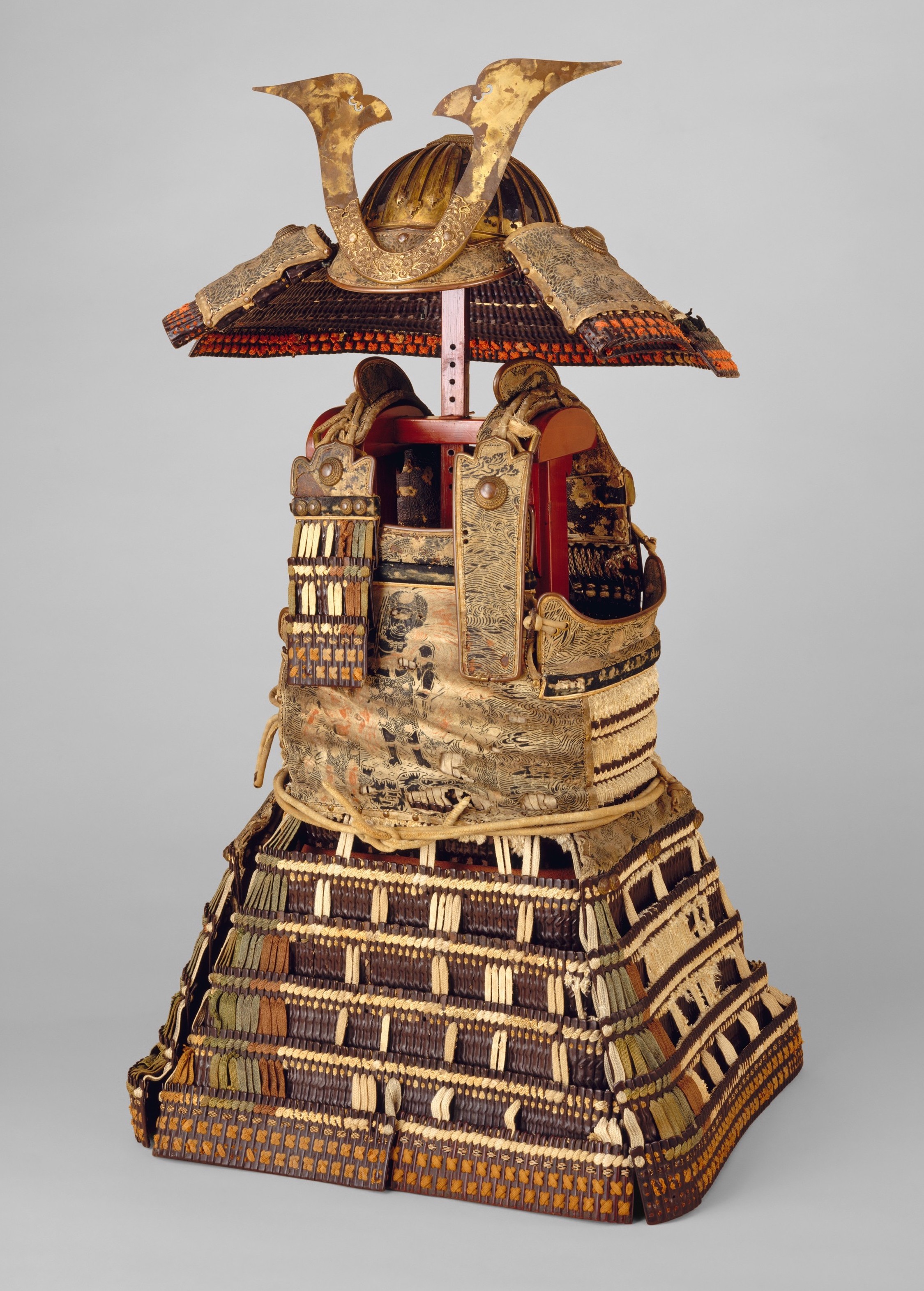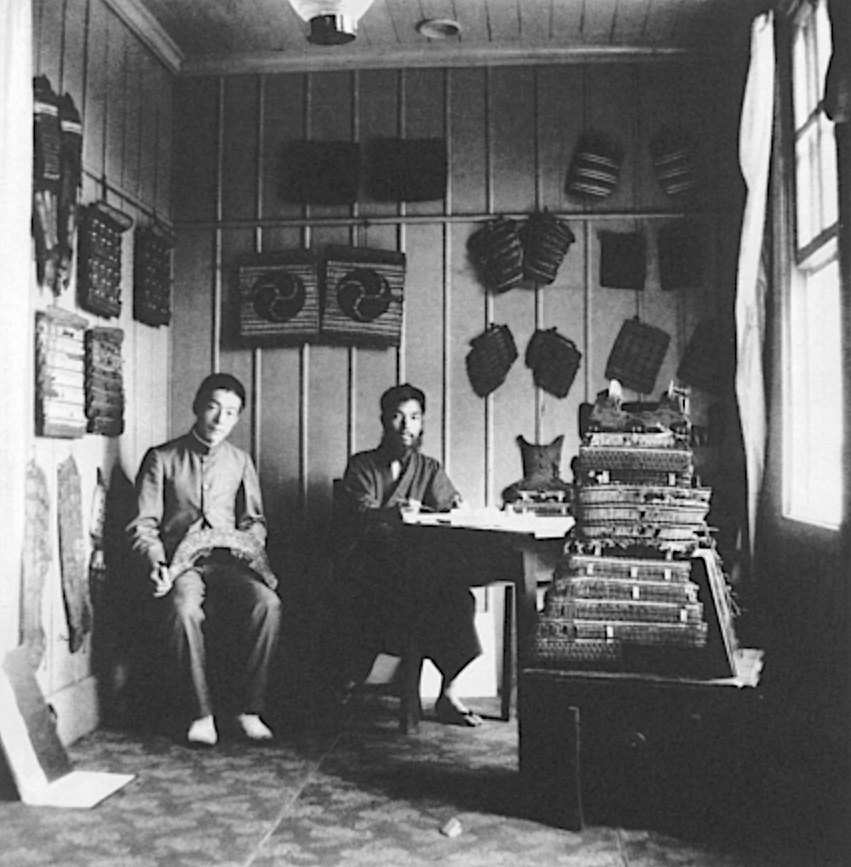As my recent Facebook post on the Ashikaga Takauji armor gained some traction, I thought I better recap the provenance/details of that ō-yoroi in a post here. Before we start, I would like to mention that the detailed research on the armor referenced here was carried out by Mr. Ogawa Morihiro (小川盛弘), Special Consultant Emeritus of The Metropolitan Museum of Ar, in the 1980s. Also, for more high-res pictures of the suit, please check out the museum’s website here.

The armor in question (14.100.121b-e).
For the most part of its life, which spans over almost 700 years of existence, the armor is thought to have been preserved in the Shinomura Hachimangū (篠村八幡宮), located in former Tanba province, just on the Western outskirts of Kyōto (close to the present-day town of Kameoka). When Ashikaga Takauji (足利尊氏, 1305-1358) was heading from Kamakura to Kyōto to fight the army that Emperor Go-Daigo (後醍醐天皇, 1288-1339) had just raised in Hōki province in another attempt to overthrow the Kamakura Shogunate, he stayed for ten days at that very Shinomura Shrine to pray for victory in battle. Tradition has it that he donated the armor in question to the shrine to appease Hachiman, the God of War. He indeed win by the way and you can easily google the history of events.
 Portrait of a mounted warrior, long believed to depict Ashikaga Takauji.
Portrait of a mounted warrior, long believed to depict Ashikaga Takauji.
Now we have to fast forward 570 years as the earliest thing we know for certain brings us to around 1902~1903, which was when the Kyōto-based antique dealer Ide Zenbei (井手善兵衛), who ran a store named Jidai’ya (時代屋) on Kyōto’s Shijō Street, bought the armor from the local Matsui (松井) family. Ide then sold it to Bashford Dean on July 19, 1905 for 1,200 Yen (about $17,000 today) who in turn gave it as a gift to The Metropolitan Museum of Art in 1914 whose first Arms and Armor Curator he had become two years prior. We neither know when the armor left the Shinomura Hachimangū and came into the possession of the Matsui, nor if it went directly from the shrine to the family or through “detours.”
There exist detailed drawings of the armor which mention Matsui Kyōsaku (松井杏朔), a physician in the service of the Kameyama fief (亀山藩), the domain in which the Shinomura Hachimangū was located, as its owner. There are fief records extant which indeed list Matsui Kyōsaku as a physician, namely for the year Tenmei five (天明, 1785). Thus, it appears that the armor was already owned by the Matsui family as early as by the late 18thcentury. Incidentally, a member of the Matsui who died in Tenpō 13 (天保, 1842), who may have been the same person as Kyōsaku, donated the substantial sum of 120 silver pieces to a local temple, which tells us that the family was well off and therefore perfectly capable of owning such an armor. Another possible scenario: The armor was owned by the shrine but given into the custody of the Matsui family, probably patrons of the Shinomura Hachimangū as well, for safekeeping. After several generations, the lines between the actual owner and the safekeeper had become blurred and the maker of the drawings erroneously identified Matsui Kyōsaku as owner. And by another 70+ years later, when Ide bought it, the Matsui were assuming the armor was in their possesion. By the way, the drawings bear the “Matsuoka Library” seal and so it is assumed that they were done by Matsuoka Yukiyoshi (松岡行義, 1794-1848). Yukiyoshi was a retainer of the Kurume fief (久留米藩) in Chikuzen province, a scholar of court/military practices, and was also engaged in armor making, hence the detailed and precise drawings of the ō-yoroi in question.
 Inside of Bashford Dean’s house in Misaki.
Inside of Bashford Dean’s house in Misaki.
Back to when Dean bought the suit. There exists a photograph from the inside of the house that Dean had built himself at Misaki (Kanagawa Prefecture, about 40 miles to the south of Tōkyō) which shows the armor put up on a chest. The two sode which were associated with the suit are hanging on the left wall and the helmet was put on a helmet stand but placed on a table on the other side of that room (shown in another photograph). In his studies, Mr. Ogawa has pointed out that neither the sode nor the helmet are original to the suit, although being very close in production time and interpretation (one sode however, the right one, was completely different and was deaccessioned by the museum later). Interestingly, the very sode and helmet are depicted in Matsuoka’s illustrations, so they are associated with the armor from at least the late 18th, early 19th century onwards. The whereabouts of the right sode are unknown.

The left sode in the collection of The Metropolitan Museum of Art (14.100.50).
Also, the period photograph shows that the armor was fixed up before it was shipped to the US, e.g. the front and rear segments of the kusazuri had become completely separated from the dōa nd the bottom suso no ita of the right front segment was missing (and replaced accordingly). As mentioned, Dean gifted the armor in 1914 to The Metropolitan Museum of Art and the rest is history. Since then, it has been studied and published multiple times (e.g. by the famous grand scholar of armor, Yamagami Hachirō, 山上八郎) and in 1986, the city of Ashikaga, the place of origin of the clan of the same name, had commissioned master armorer Myōchin Muneyuki (明珍宗恭, 1917-2011) with creating a replica of the entire suit.

Photograph from before the armor was fixed up (with the sode attached).
Finally I want to address the interpretation of the armor. It comes under the classification of a shiroito tsumadori ō-yoroi (白糸褄取大鎧), an “large classical armor laced in white with color accents.” It features a sendan no ita and a kyūbi no ita and the front of the dō is covered with a very impressive tsurubashirigawa that depicts the deity Fudō-Myōō (不動明王, Acala) and next to him Kongara-Dōji (矜羯羅童子, Kimkara) and Seitaka-Dōji (制多迦童子, Cetaka), his two boy servants. Ō-yoroi of this age are extremely rare, even more when they preserve, like the example in The Metropolitan Museum of Art, parts of their original lacing. It boils down to less than 40 specimen and if the armor had remained in Japan, it would today be designated as a jūyō-bunkazai, an Important Cultural Asset.

Detail of the tsurubashirigawa.
Last but not least, the background for my Facebook post was that our Department for Arms and Armor had to check the transportability of the armor for an upcoming interdepartmental loan and when everything works out as planned, the suit will be reunited with its helmet (although not originally together but “married” for at least 200 years) and displayed in an exhibition later this summer. I will of course make an announcement here and on my usual social media channels, so stay tuned.